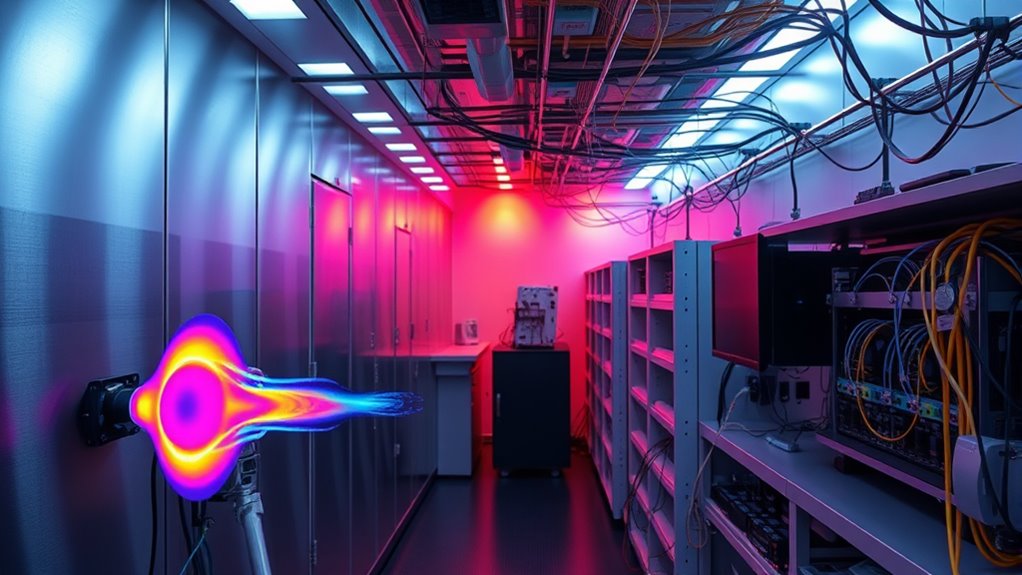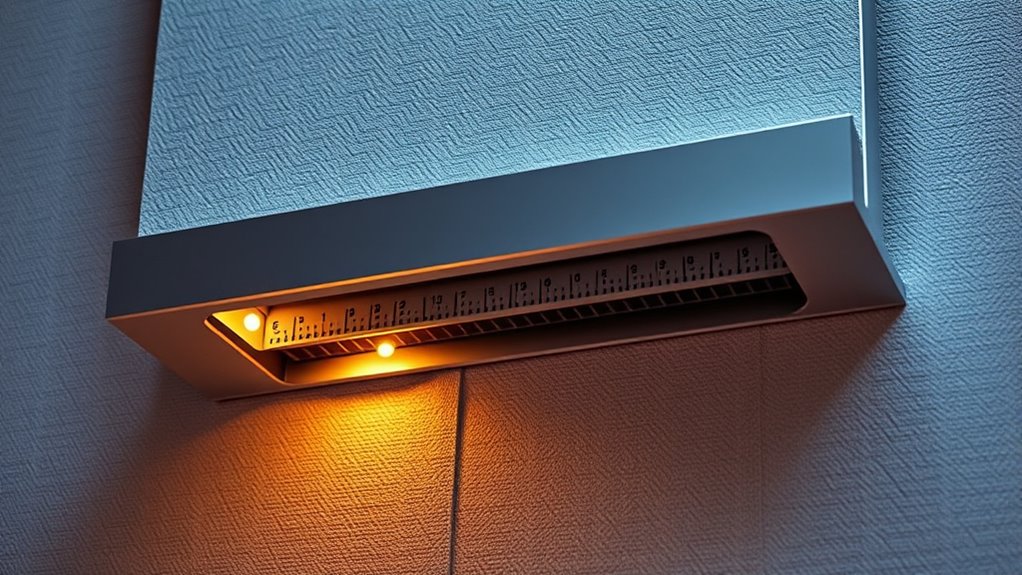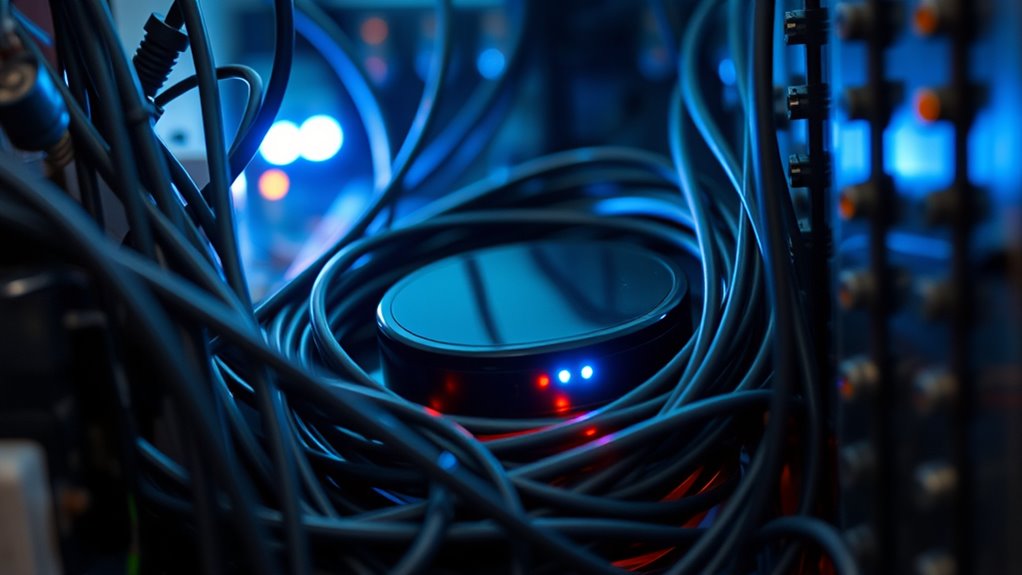Unaddressed EMF considerations in infrared systems can lead to unforeseen health risks, costly regulatory hurdles, and expensive shielding or mitigation measures. You might also face equipment malfunctions, performance issues, and increased maintenance costs that shorten system lifespan. These hidden expenses can strain your budget if you don’t proactively manage EMF factors. Staying ahead by understanding safety practices, proper shielding, and regular monitoring helps avoid these pitfalls. Keep exploring to discover how to keep costs low while ensuring safety.
Key Takeaways
- Investing in durable, high-quality shielding materials and proper installation reduces long-term maintenance and replacement costs.
- Regular EMF level testing and expert consultation help identify issues early, preventing costly repairs and system failures.
- Staying updated on evolving standards minimizes legal liabilities and compliance-related expenses.
- Implementing proactive maintenance strategies extends equipment lifespan and enhances operational efficiency.
- Proper system design, including effective filtration and placement, prevents unnecessary over-engineering and reduces hidden expenses.
Unanticipated Health Risks and Their Financial Impact

While infrared technology offers many benefits, overlooking the potential health risks associated with electromagnetic fields (EMF) can lead to unexpected costs. Long-term exposure to EMF can cause biological effects that may not be immediately evident. Over time, these effects might include cellular stress, disrupted sleep patterns, or increased risks of certain health conditions. If you ignore these risks, you could face costly legal liabilities, increased healthcare expenses, or reputational damage. Employers and manufacturers may need to invest heavily in mitigation measures or health monitoring programs later on. By understanding the biological effects associated with prolonged EMF exposure, you can proactively implement safety standards and reduce the likelihood of unforeseen financial burdens stemming from health-related issues. Additionally, awareness of vetted safety practices can help prevent unnecessary expenditures and safeguard long-term well-being.
Increased Regulatory and Compliance Challenges

As infrared technology becomes more widespread, steering the evolving landscape of regulations and compliance standards can pose considerable challenges. You’ll face increased regulatory hurdles, requiring ongoing adjustments to meet changing standards. Compliance costs also rise as you invest in testing, documentation, and certification processes. To illustrate, consider this:
| Challenge | Impact |
|---|---|
| Regulatory hurdles | Delays product launches and increases costs |
| Compliance costs | Strains budgets and resource allocation |
| Evolving standards | Demands continuous updates and training |
| Market restrictions | Limits distribution channels |
These hurdles demand your attention and resources, making it critical to stay proactive in understanding and adapting to regulation shifts. Failing to do so can result in fines, product recalls, or market bans, considerably increasing hidden costs. Staying informed about regulatory compliance standards is essential for long-term success.
Elevated Costs of Shielding and Mitigation Measures

When you implement shielding and mitigation measures, you’ll face significant material costs upfront. Ongoing maintenance and eventual replacements add to these expenses over time. These hidden costs can quickly outweigh initial investments, impacting your overall budget. Additionally, neglecting proper communication about digital boundaries may lead to emotional distress, which can have long-term financial and relational consequences.
Shielding Material Expenses
Shielding materials designed to mitigate electromagnetic fields (EMF) in infrared applications often come with substantially higher costs than initially expected. You’ll find that high-quality materials must withstand environmental stresses, so material durability is a key factor driving up expenses. Additionally, these materials can be challenging to install, requiring specialized skills and precise methods that increase labor costs. Complex installation processes may involve custom fittings or extra protective layers, further elevating costs. You might also need thicker or layered shields to ensure effectiveness, which adds to material expenses. While durability and installation ease are critical, they substantially influence the overall budget. Expect to pay a premium for materials that balance longevity with manageable installation, ensuring your EMF mitigation measures remain effective and cost-efficient over time. Moreover, contrast ratio considerations in projector image quality can also influence the effectiveness of visual displays used in monitoring or presentation setups related to infrared applications.
Maintenance and Replacement
Maintaining and replacing EMF shielding materials can quickly escalate your ongoing costs. Over time, you may face costly replacements as certain materials degrade or lose effectiveness, requiring frequent upgrades. The ongoing upkeep involves regular inspections, cleaning, and repairs to ensure continued protection against EMF exposure. These maintenance tasks can become expensive, especially if you need to replace entire shielding sections or upgrade to more advanced solutions. Additionally, specialized labor and materials add to the overall expense. If you don’t plan for these recurring costs, your project’s budget can quickly spiral out of control. To avoid unnecessary expenses, consider investing in durable shielding options upfront and establishing a maintenance plan that minimizes frequent replacements and reduces long-term costs.
Performance Degradation Due to EMF Interference

EMF interference can cause your infrared systems to experience signal disruptions, leading to inconsistent performance. These disturbances often result in equipment malfunctions that disrupt your operations. As a result, you might face increased maintenance costs and reduced efficiency across your processes. Recognizing the importance of trust issues in maintaining system integrity can help prevent misunderstandings and ensure smoother operation.
Signal Disruption Risks
While infrared systems are designed to operate smoothly, electromagnetic fields (EMF) can interfere with their signals, leading to noticeable performance issues. Signal interference caused by EMF can disrupt data transmission, compromising data integrity and causing delays or errors. This disruption affects system reliability and can result in miscommunication between devices. To visualize this, imagine the following:
| EMF Interference Effect | Resulting Issue |
|---|---|
| Weak Signal | Loss of data accuracy |
| Signal Fluctuation | Erroneous readings |
| Signal Blockage | Communication breakdown |
These issues highlight how EMF can compromise your infrared system’s performance, emphasizing the importance of managing electromagnetic interference to maintain reliable, high-quality operation. Understanding the psychological impacts of such interference can also help in designing systems that are more resilient against narcissistic manipulation, ensuring that technical disruptions do not lead to human misunderstandings or conflicts.
Equipment Malfunctions Increase
Electromagnetic interference can directly cause equipment malfunctions, leading to noticeable performance issues. When EMF disrupts your devices, you might notice inaccurate readings or system errors. Over time, this interference can compromise equipment calibration, making your tools less dependable. To minimize these problems, regular calibration is essential, especially if EMF levels fluctuate. Additionally, providing proper user training helps you recognize early signs of interference and respond effectively. Without these precautions, equipment may operate inefficiently or break down unexpectedly, increasing downtime and repair costs. Managing EMF exposure ensures your infrared systems run smoothly and consistently. Understanding the vulnerabilities of AI models like GPT-4 to bias and security risks highlights the importance of safeguarding your equipment from interference. By understanding how EMF impacts your equipment and taking proactive steps, you can avoid costly malfunctions and maintain ideal performance.
Hidden Expenses in Maintenance and System Longevity

Understanding the hidden expenses associated with EMF considerations in infrared systems is crucial because overlooked maintenance issues can quickly escalate costs and shorten system lifespan. When EMF-related components aren’t properly maintained, energy efficiency drops, leading to higher operating costs over time. Neglecting regular inspections can cause subtle damage that compromises system performance and durability, resulting in costly repairs or replacements. Additionally, if safety protocols aren’t consistently followed, user safety can be at risk, potentially leading to accidents or health concerns that demand further expenses. These hidden costs often go unnoticed until they cause significant problems, making proactive maintenance essential. Proper filtration and pump protection are vital for maintaining system integrity and preventing these costly issues. By prioritizing routine check-ups and maintenance, you can extend your system’s longevity, optimize energy use, and ensure user safety, ultimately saving money in the long run.
Strategies for Cost-Effective EMF Management

Implementing cost-effective EMF management begins with strategic planning and regular monitoring. By adopting proactive planning, you can identify potential EMF issues early and prevent costly repairs or upgrades. Use cost-saving techniques such as proper equipment placement and shielding to minimize EMF exposure without overspending. Investing in quality materials upfront reduces long-term maintenance costs and ensures consistent performance. Regularly measuring EMF levels allows you to make informed adjustments, avoiding unnecessary expenses. Educate yourself on ideal system configurations to prevent over-engineering, which can inflate costs. Collaborating with experts to develop tailored solutions that balance safety and budget is also essential. Additionally, understanding sound healing science can provide insights into how sound vibrations influence health, potentially informing safer infrared system designs. This approach helps you control expenses while maintaining effective EMF management, ultimately safeguarding your infrared systems without sacrificing financial efficiency.
Frequently Asked Questions
How Do EMF Considerations Affect Long-Term Infrastructure Investments?
You should factor EMF considerations into your long-term infrastructure investments through thorough cost benefit analysis and risk mitigation strategies. Ignoring EMF risks could lead to unforeseen costs, health concerns, and potential regulatory challenges down the line. By proactively addressing EMF issues, you guarantee safer, more sustainable infrastructure, minimizing future expenses and liabilities. This approach helps you make informed decisions that balance initial costs with long-term safety and efficiency.
What Are the Legal Liabilities Associated With EMF Exposure in Infrared Systems?
Ever wondered what happens if you ignore EMF exposure risks? You could face significant legal liabilities if your infrared systems don’t meet safety standards. Ensuring legal compliance minimizes liability risks, protecting you from lawsuits or fines. Staying informed about regulations and implementing proper shielding helps you avoid legal trouble. By proactively managing EMF exposure, you safeguard your reputation and prevent costly legal consequences down the line.
Can EMF Shielding Impact the Efficiency of Infrared Equipment?
Yes, EMF shielding can impact the efficiency of infrared equipment. When you implement shielding, it may cause electromagnetic interference (EMI), which can disrupt signal quality. To maintain peak performance, you should focus on shielding effectiveness, ensuring it blocks unwanted EMF without hindering infrared signals. Properly designed shielding balances protection and efficiency, preventing unnecessary loss of infrared output while reducing potential electromagnetic interference issues.
Are There Industry Standards for EMF Emissions in Infrared Applications?
Think of industry standards for EMF emissions like speed limits on a highway—they keep things safe and consistent. Yes, there are specific EMF regulations for infrared applications, set by organizations like IEEE and ICNIRP. These standards make sure equipment operates within safe limits, preventing potential health risks and interference. Following these guidelines helps you avoid hidden costs and ensures your infrared devices stay compliant and efficient.
How Does EMF Management Influence Overall Project Timelines and Budgets?
Effective EMF management can substantially impact your project timelines and budgets. By incorporating cost estimation for EMF mitigation early on, you avoid unexpected expenses later. Ensuring compliance with regulations streamlines approvals and reduces delays. Proper planning minimizes revisions and rework, saving time and money. Ultimately, proactive EMF considerations help you stay within budget and meet deadlines, making your project smoother and more cost-efficient.
Conclusion
By understanding the hidden costs of EMF considerations, you’re steering a minefield of unforeseen risks and mounting expenses. Think of it as tending a garden—you must carefully prune and shield your plants to prevent unseen weeds from choking your progress. With proactive strategies, you’ll clear a path through the tangled underbrush of compliance, maintenance, and performance issues, ensuring your system thrives without costly surprises. Stay vigilant, and your infrared journey will blossom smoothly and sustainably.









